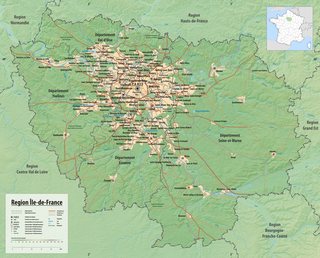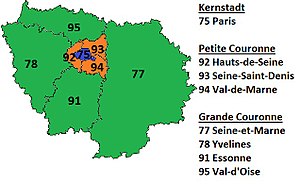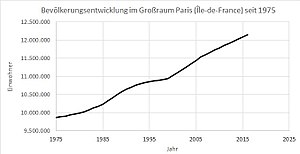Île-de-France
| Île-de-France | |
|---|---|
| Basic data | |
| Country |
|
| prefecture | Paris |
| President of the Regional Council | Valérie Pécresse ( LR ) |
| population | 12,278,210 (2020) |
| Population density | 1,022.2 inhabitants per km² |
| surface | 12,011 km² |
| Departments | 8th |
| Arrondissements | 25th |
| Community associations | 63 |
| Cantons | 155 |
| Communities | 1,268 |
| ISO-3166-2 code | FR-IDF |
 Relief map of the Île-de-France region |
|
The Île-de-France [ il dəˈfʀɑ̃s ] is a region in northern France that is largely identical to the Paris metropolitan area and is therefore also known as the Paris agglomeration . The region consists of the city of Paris (with serial number 75) and the departments of Essonne (91), Hauts-de-Seine (92), Seine-et-Marne (77), Seine-Saint-Denis (93), Val- d'Oise (95), Val-de-Marne (94) and Yvelines (78). It has an area of 12,012 km² and 12,278,210 inhabitants (as of January 2020). Important cities besides Paris, which is also the administrative center of the region, are Versailles , Boulogne-Billancourt , Montreuil , Argenteuil and Saint-Denis . The inhabitants are called Franciliens . The department with the ordinal number 75 forms the core city, the departments 92, 93 and 94 form the Petite Couronne (1st, inner suburb belt) and the departments 77, 78, 91 and 95 the Grande Couronne (2nd, outer suburb belt).
The name Île-de-France ( English island of France ) is mostly explained today with the location between the rivers Seine , Marne , Oise and Beuvronne , which surrounds the area like an island. Possibly the name goes back to an old Franconian name Liddle Franke , ie "Kleinfranken" or "Kleinfrankreich". As the Zone d'études et d'aménagement du territoire and NUTS 1 region , it is now also called Région parisienne (“Paris Region”).
The most common dialects in Île-de-France are Champenois and Francien .
history
Historically, the Île-de-France is the heartland of France, to which names such as Francia or Franzien usually refer. The standard French language is based on the Île-de-France dialect.
Since the subjugation of Syagrius by Clovis I , the area has been a political center of the Merovingian and Carolingian Franconian empire with only a brief interruption in the 7th century and, from the 9th century, of western France , i.e. later France. For centuries it was identical to the French crown domain , the Domaine royal . From here the Gothic spread , which was originally the architectural style of this region only and thus also the French "royal style". From Louis XIV onwards, the French kings ruled from Versailles , where they created the imposing and much-copied Palace of Versailles .
Until the French Revolution , Île-de-France was one of the historic provinces of France . With the formation of the departments in 1789/1790, it was dissolved as an administrative unit.
When the program regions (Régions de programme) were formed in 1956, the area was initially named Région Parisienne . In 1976 the Région Parisienne was renamed Île-de-France . However, in some areas the territory of the new region differs significantly from that of the former province. Like the other regions, Île-de-France has had a directly elected regional council since 1986 .
population
Demographics
The population of 10,952,011 at the time of the 1999 census has increased to 12,278,210 by 2020 , according to an estimate by INSEE , which means that the population density has increased from 912 to 1022 inhabitants per km². The Île-de-France is by far the most populous and densely populated region of France. In 2020, 18.9% of the total population of European France lived in Île-de-France.
The majority of the inhabitants live in the urban agglomeration ( Unité urbaine ) around Paris, which with 9,644,507 inhabitants (1999) is the largest in France and one of the largest in Europe. Only thirteen years later, in 2012, the population of the Unité urbaine was already 10,550,350 and in 2015 10,706,072.
In the metropolitan area of Paris ( Aire urbaine ), which is relatively identical to the Île-de-France region, there were 12,405,426 inhabitants in 2013 and 12,532,901 in 2015. In 2016 the population was already 12,568,755.
|
Population development in the Île-de-France since 1801
|
According to a forecast from 2013, the population of Île-de-France is expected to increase by a further 1.1 million between 2010 and 2030. In 2050, the population is even expected to exceed 15 million.
The following table shows the population development in the Île-de-France since 1876, broken down into its eight departments : The data refer to the current territory, which has remained unchanged since the territorial reform in Île-de-France in 1968.
On January 1, 1968, under a law of 1964, the Seine and Seine-et-Oise departments were dissolved. The newly created Paris department was given the number 75 of the former Seine department . The Yvelines department was given the number 78 of the former Seine-et-Oise department . Three newly created departments were given the numbers of the former Algerian departments Alger, Oran and Constantine: Essonne received 91, Hauts-de-Seine 92, Seine-Saint-Denis 93. The departments Val-de-Marne received new numbers with the 94 and Val-d'Oise with 95. The Seine department was divided into the four new departments of Paris (consisting only of the city of Paris), Hauts-de-Seine , Seine-Saint-Denis and Val-de-Marne . The last three departments mentioned also include some municipalities that were previously part of the Seine-et-Oise department . The Seine-et-Oise department has been split into three new departments: Yvelines , Essonne and Val-d'Oise . Only the department of Seine-et-Marne , with the serial number 77, remained untouched by the territorial reform.
As can be seen in the following table, at the beginning of the 20th century the population increase mainly took place in Paris and the Petite Couronne . The population of Paris has been declining since the 1930s, due to the severe overpopulation with a population density of around 30,000 inhabitants per km² for the city of Paris in the 1920s. Paris was considered the most densely populated metropolis in Europe. Furthermore, the population density decreased due to the modernization of apartments and the amalgamation of small apartments (Paris has a very old building fabric). The reduction in the average household size, the creation of offices and the better accessibility of the center due to the ever better developed local public transport and newly built highways into the banlieues also contributed to this development.
After decades of population decline, Paris saw population growth again between 1997 and 2011. However, the number of inhabitants has been falling again since 2012.
Population growth in the Petite Couronne has stagnated since the 1960s, before it has continued to grow again since the late 1990s.
While the population grew mainly in Paris and the Petite Couronne until the 1950s and the Grande Couronne only grew less, that changed in the 1950s, when the population has continued to grow in the Grande Couronne since then. The Grande Couronne grew particularly strongly in the 1960s and 1970s due to the construction of large housing estates and huge new building areas and the expansion of the Villes nouvelles , which are all located in the Grande Couronne.
Today the Petite Couronne is almost completely urbanized and has a very high population density with an average of 5,000 to 9,000 inhabitants per km², depending on the department. With over 20,000 inhabitants per km², Paris is still the most densely populated metropolis in Europe. The Grande Couronne also has a high population density for area départements, with the areas bordering the Petite Couronne showing a high degree of urbanization and the cities seamlessly merging with the cities of the Petite Couronne and these in turn seamlessly merging with Paris.
Nowadays, all seven suburban departments of the Île-de-France are growing in terms of population, with the Petite Couronne (because of its proximity and easy access to the center and lower prices than in Paris) and the Seine-et-Marne department because of the growth in many new development areas. In all the Île-de-France departments, population growth is due solely to a surplus of births. This is around 110,000 people per year (with around 180,000 births and 70,000 deaths per year in Île-de-France). With the exception of the Seine-et-Marne department, all of the Île-de-France's departments have a negative migration balance. This is around −50,000 people per year. As a result, the region is growing by around 60,000 people per year, which corresponds to an annual increase of 0.5% and thus exactly corresponds to the national average.
Since the mid-1970s, the Île-de-France region has experienced a loss of migration compared with the rest of France. Until then, the region had seen large gains in migration. The reasons for the loss of migration are the high price level, the shortage of housing, the hectic city bustle and the desire for more living space, which can only be fulfilled in rural areas due to the high prices. The region is recording high migration losses, especially in the over 50 age group, which is due to the fact that many settle in the country when they retire or because of the better weather in southern France.
It remains to be seen how the planned increase in the number of newly built apartments per year in Île-de-France from currently 40,000 to 70,000 as part of the Le Grand Paris project will affect population growth.
|
Population development in detail by department in the Île-de-France since 1876
|
|||||||||||||||||||||||||||||||||||||||||||||||||||||||||||||||||||||||||||||||||||||||||||||||||||||||||||||||||||||||||||||||||||||||||||||||||||||||||||||||||||||||||||||||||||||||||||||||||||||||||||||||||||||||||||||||||||||||||||||||||||||||||||||||||||||||||||||||||||||||||||||||||||||||||||||||||||||||||||||||||||||||||||||||||||||||||||||||||||||||||||||||||||||||||||||||||||||||||||||||||||||||||||||||||||||||||||||||||||||||||||||||||||||||||||||||||||||||||||||||||||||||||||||||||||||||||||||||||||||||||||||||||||||||||||||||||||||||||||||||||||||||||||||||||||||||||||||||||||||||||||||||||||||||||||||||||||||||||||||||||||||||||
Cities
The most populous cities in Île-de-France are:
| city | Inhabitants (year) | Department |
|---|---|---|
| Paris | 2,187,526 (2017) | Paris |
| Boulogne-Billancourt | 120,071 (2017) | Hauts-de-Seine |
| Saint-Denis | 111,135 (2017) | Seine-Saint-Denis |
| Argenteuil | 110,210 (2017) | Val d'Oise |
| Montreuil | 109,897 (2017) | Seine-Saint-Denis |
| Nanterre | 95,105 (2017) | Hauts-de-Seine |
| Vitry-sur-Seine | 93,557 (2017) | Val-de-Marne |
| Créteil | 90,605 (2017) | Val-de-Marne |
| Asnières-sur-Seine | 85,191 (2017) | Hauts-de-Seine |
| Versailles | 85,862 (2017) | Yvelines |
| Colombes | 85,177 (2017) | Hauts-de-Seine |
| Aubervilliers | 86,375 (2017) | Seine-Saint-Denis |
| Aulnay-sous-Bois | 85,740 (2017) | Seine-Saint-Denis |
| Courbevoie | 81,719 (2017) | Hauts-de-Seine |
| Rueil-Malmaison | 78,152 (2017) | Hauts-de-Seine |
| Champigny-sur-Marne | 77,630 (2017) | Val-de-Marne |
| Saint-Maur-des-Fossés | 74,859 (2017) | Val-de-Marne |
There are a total of 130 cities with more than 25,000 inhabitants in the Île-de-France, 39 of which have more than 50,000 inhabitants (as of January 1, 2012).
politics
Political structure

|

|
|
|
On the left the Île-de-France on the eve of the revolution with its old districts. On the right, the new territorial division into departments by law of December 22, 1789 by the Constituent Assembly
|
||


The Île-de-France region is divided into eight departments :
| OZ | = Ordinal number of the department | Arr. | = Number of arrondissements | According to | = Number of municipalities |
| W. | = Coat of arms of the department | Kant. | = Number of cantons | ||
| ISO | = ISO-3166-2 code | GV | = Number of municipal associations |
| OZ | W. | Department | prefecture | ISO | Arr. | GV | Kant. | According to | Residents January 1, 2017 |
Area (km²) |
Density (inh / km²) |
|---|---|---|---|---|---|---|---|---|---|---|---|
| 75 |
|
Paris | Paris | FR-75 | 1 | 1 | - | 1 | 2,187,526 | 105 | 20,834 |
| 77 |
|
Seine-et-Marne | Melun | FR-77 | 5 | 23 | 23 | 507 | 1,403,997 | 5,914 | 237 |
| 78 |
|
Yvelines | Versailles | FR-78 | 4th | 11 | 21st | 259 | 1,438,266 | 2,286 | 629 |
| 91 |
|
Essonne | Evry | FR-91 | 3 | 14th | 21st | 194 | 1,296,130 | 1,804 | 718 |
| 92 |
|
Hauts-de-Seine | Nanterre | FR-92 | 3 | 5 | 23 | 36 | 1,609,306 | 176 | 9,144 |
| 93 |
|
Seine-Saint-Denis | Bobigny | FR-93 | 3 | 5 | 21st | 40 | 1,623,111 | 236 | 6,878 |
| 94 |
|
Val-de-Marne | Créteil | FR-94 | 3 | 4th | 25th | 47 | 1,387,926 | 245 | 5,665 |
| 95 |
|
Val d'Oise | Pontoise | FR-95 | 3 | 13 | 21st | 184 | 1,228,618 | 1,245 | 987 |
| total | 25th | 63 | 155 | 1,268 | 12,174,880 | 12,011 | 1.014 | ||||
Regional council
Result of the election of the regional council on December 13, 2015:
- List Valérie Pécresse (Union de la Droite from LR and UDI ): 43.80% = 1,629,410 votes, 121 seats
- Claude Bartolone's list (Union de la Gauche from PS , PRG , EELV and FG ): 42.18% = 1,569,262 votes, 66 seats
- List Wallerand de Saint-Just ( FN ): 14.02% = 521,493 votes, 22 seats
The seat of the regional council is 33 rue Barbet-de-Jouy .
Petite Couronne and Grande Couronne

Since the problems of the inner departments bordering Paris often differ considerably from those of the more outlying departments, an (informal) distinction is occasionally made in this sense.
The Petite Couronne , the inner ring that surrounds Paris, summarizes the three departments that border Paris: Hauts-de-Seine (92), Seine-Saint-Denis (93) and Val-de-Marne (94) . Together with Paris, these essentially formed the Seine department until 1967. They are heavily urbanized, with a high population density.
The Grande Couronne , the outer wreath, consists of the departments of Seine-et-Marne (77), Yvelines (78), Essonne (91) and Val-d'Oise (95). The inner part of the Grande Couronne, which connects to the Petite Couronne, is also heavily urbanized. The urbanized zone in the Île-de-France, which is continuously built up, has a diameter of around 70 kilometers. Outside of this area, the Grande Couronne is still very rural in many areas. The only exceptions are a few regional centers such as Rambouillet , Provins and Étampes .
economy
The Île-de-France region is by far the wealthiest in France and one of the most important economic areas in the world. The share of France's economic output was 30.5% in 2016, which corresponds to around 680 billion euros . Compared with the GDP of the EU expressed in purchasing power standards reached the region in 2015 an index of 176 (EU-28 = 100). In 2017 the unemployment rate was 8.7% and was thus below the French average.
The amusement park Disneyland Resort Paris has existed in Marne-la-Vallée east of Paris since 1992 .
One of the main business centers is La Défense , a high-rise district on the western edge of the city of Paris.
traffic
The public transport in Paris and the Ile-de-France is ensured by the following means of transport:
See also
literature
- Jean Firges : The City of Paris. History of their development and urbanization . (= Cultural history series, 3). Sonnenberg, Annweiler 1998, ISBN 3-933264-00-6 .
- Klaus Bussmann : Paris and the Île de France. Art travel guide . 9th edition. Dumont, Cologne 1997, ISBN 3-7701-1067-6 .
Web links
- Region Île-de-France (French, English partly, Spanish partly)
- Prefecture of the Île-de-France region (French)
Individual evidence
- ↑ a b Source: https://www.insee.fr/fr/statistiques/1893198
- ↑ Source: http://www.insee.fr/fr/ffc/chifcle_fiche.asp?ref_id=NATTEF01204&tab_id=201
- ^ Unité urbaine 2010 de Paris. Retrieved September 19, 2014 .
- ↑ dossier complet: Unité urbaine de Paris (00851). INSEE , September 25, 2018, accessed October 8, 2018 (French).
- ↑ Les 60 premières aires urbaines en 2013. Accessed March 21, 2016 .
- ↑ INSEE: Tableaux de l'économie française 2018 . Retrieved August 10, 2018.
- ↑ INSEE: Entre 2011 et 2016, les grandes aires urbaines portent la croissance demographique française . Retrieved January 19, 2019.
- ^ L'Île-de-France en 2030. Archived from the original on June 16, 2013 ; Retrieved December 10, 2012 .
- ↑ A quoi ressemblera l'Ile-de-France in 2050? Retrieved March 3, 2014 .
- ↑ L'objectif du Grand Paris de construire 70,000 logements par an sera difficile à tenir. Retrieved September 9, 2016 .
- ↑ Résultats régionales 2015 on linternaute.com, accessed on January 11, 2016
- ↑ Eurostat. Retrieved August 22, 2018 .
- ↑ Unemployment rate, by NUTS 2 regions. Retrieved November 5, 2018 .
Coordinates: 48 ° 44 ' N , 2 ° 38' E









